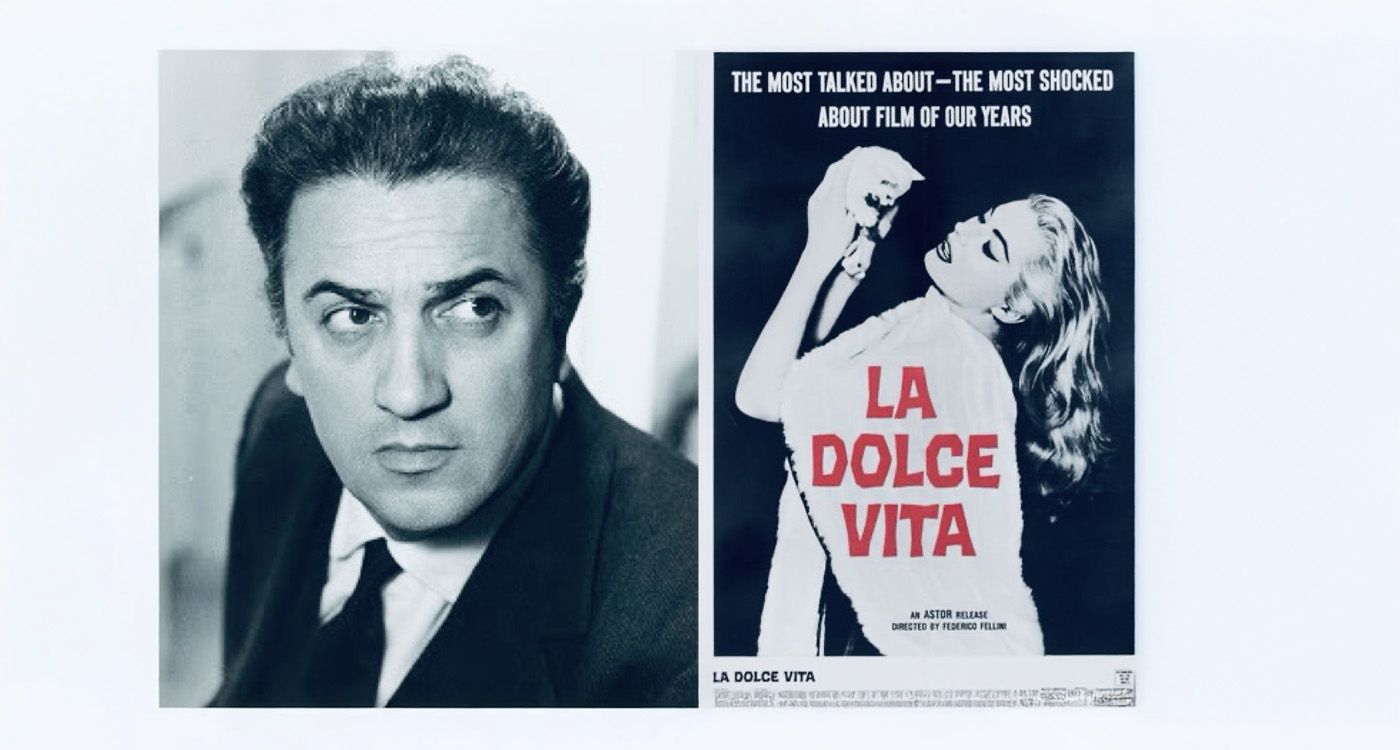
An undisputed masterpiece of world cinema, La Dolce Vita was born from a critical look at Rome and a creative chaos that only Fellini could master. Between feverish nights, media scandals and narrative freedom, here is the story behind the story.
When it was released in 1960, La Dolce Vita caused a stir. The film disrupted cinema, unsettled Italian society, and changed how we understand what a film can express. Yet this masterpiece by Federico Fellini was not born out of serenity or control. It emerged from the tumult of late 1950s Rome, where nights seemed more intense than days, and where Italy was slowly shifting from post-war poverty to a dazzling and sometimes disorienting modernity.
Fellini, already acclaimed for I Vitelloni, La Strada, and Nights of Cabiria, felt the need to film differently. He no longer wanted to follow a classical plot. He imagined a film traced by a man – Marcello Rubini, a society journalist – and all that he chases, loves and destroys. A film whose structure mirrors that of the city: chaotic, teeming and magnificent.
The idea came to him, as was often the case, while walking through the streets of Rome at night. Fellini didn’t write theoretically. He dreamed by observing. He saw men in suits chasing starlets, camera flashes, priests in limousines, children claiming to have seen the Virgin Mary. Rome became a living theater. Fellini took note of everything. He no longer wanted a neatly arranged script, but a drifting path – like Marcello’s through the city – alert eyes, a slightly lost soul.
Marcello, played by Mastroianni, is a barely veiled version of the director himself. A man who is both a spectator and participant in a world collapsing under the weight of its own glitter. A gossip journalist, he mingles with the powerful, the beautiful, the mystical, the intellectual. He moves from party to party, searching for something, finding only well-lit emptiness.
Another unforgettable character is Paparazzo. Inspired by the photographer Tazio Secchiaroli, this name, coined by Fellini, entered everyday language. Proof that the film not only captured its era, but also shaped it.
The Trevi Fountain scene is undoubtedly the most famous. Anita Ekberg, in a black dress, walks into the water with open arms. The night feels unreal. Mastroianni joins her, mesmerized. This image became legendary. And yet, the shoot was harsh – the water was freezing and the winter cold made the long night takes difficult. Ekberg endured. Mastroianni drank vodka to keep from collapsing. Fellini knew he was filming an eternal moment.
The film’s structure is unique: seven nights, six days. Some see a biblical reference, others a nod to the seven deadly sins. Fellini confirmed nothing. What mattered to him was flow, sensation. Each sequence is a world unto itself. A strange party. A visit to a weary writer. A night with a dying father. An apparition in the countryside. And Rome, omnipresent.
Upon release, the film sparked scandal. The Church attacked it, conservatives were outraged. Rome recognized itself in the mirror – for a moment – then looked away. Audiences, however, were captivated. La Dolce Vita won the Palme d’Or at Cannes and gained worldwide acclaim. Mastroianni became Fellini’s face. And Fellini became a legend.
But beyond success, La Dolce Vita became a way to read its era – Italy’s economic boom, the rise of mass media, the loss of meaning. Fellini did not condemn. He observed. His gaze was neither naïve nor cynical, but that of a poet without illusions.
And despite the emptiness he portrayed, something lingers. A trace of childhood, a face, a giant beached fish. A silent young girl. And Marcello, who no longer knows. Perhaps the answer lies in that very absence.
Far from being a film with a message, La Dolce Vita is a lucid drift. A waking dream, filmed by a man who, by showing disenchantment, reached the stars.
The Birth of a Word: ‘Paparazzi’
The word “paparazzi” did not exist before La Dolce Vita. Fellini invented it by naming a photographer in the film, inspired by real-life Roman photographer Tazio Secchiaroli. The name came from a minor character in a Gissing novel (By the Ionian Sea), which Fellini had read. Since then, the term has become universal for celebrity image hunters.


Comments